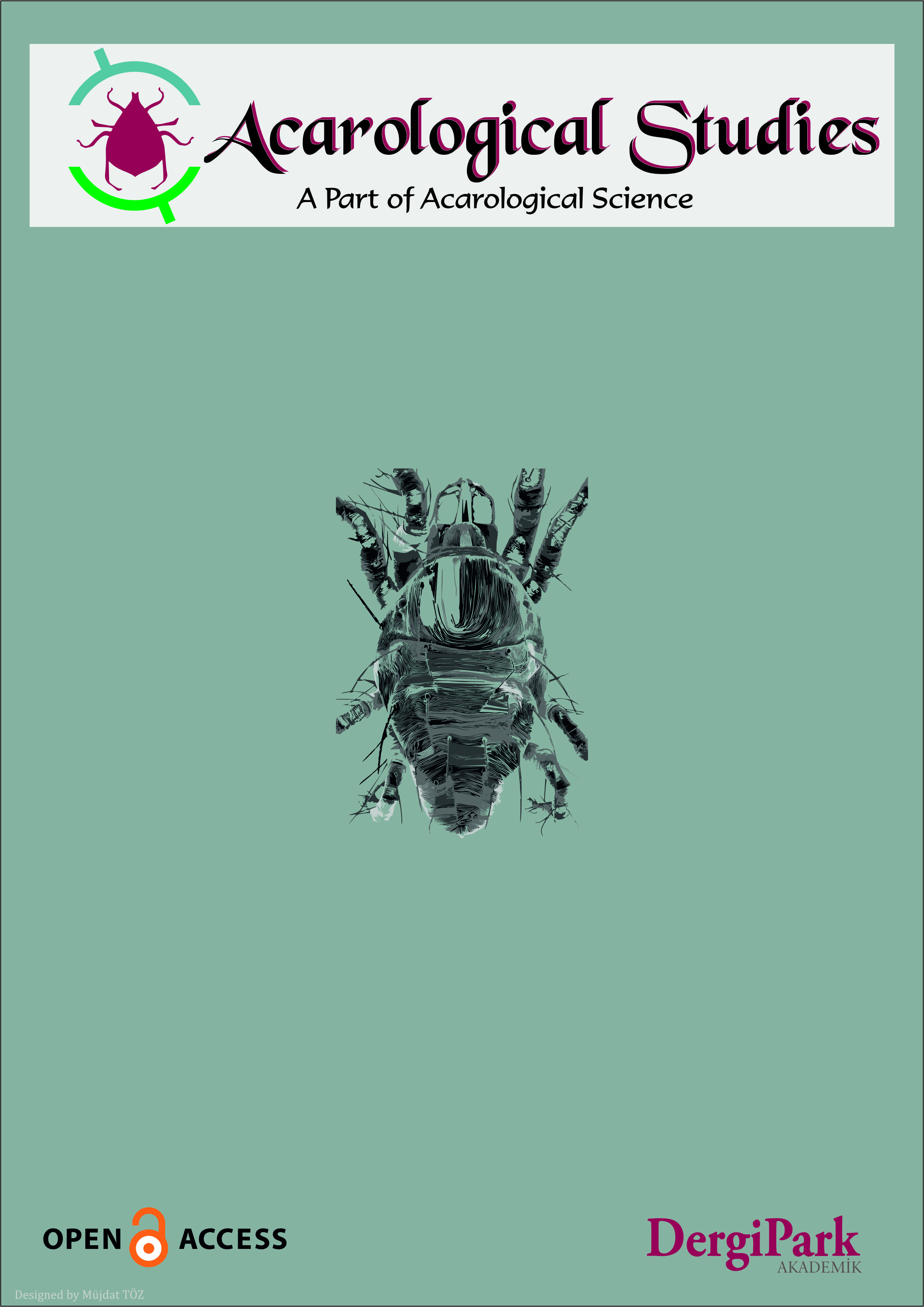Seasonal distribution and damage potential of Raoiella indica (Hirst) (Acari: Tenuipalpidae) on areca palms of Kerala, India
Areca catechu, proline, Raoiella indica, total chlorophyll total nitrogen, total phenolic compound,
___
- Arnon, D.I. 1949. Copper enzymes in isolated chloroplasts, polyphenoxidase in Beta vulgaris. Plant Physiology, 24: 1-15. doi: org/10.1104/pp.24.1.1
- Aspinall, D. and Paleg, L.G. 1981. Proline accumulation: physiological aspects. In: The Physiology and Biochemistry of Drought Resistance in Plants. Paleg, L.G. and Aspinall, D. (Eds.). Academic Press, Sydney, 205-241.
- Bale, J., Masters, G., Hodkinson, I., Awmack, C., Jnbezemer, T.M., Brown, V.K., Butterfield, J., Buse, A., Coulson, J.C., Farrar, J., Good, J.G., Harrington, R., Hartley, S., Jones, T.H., Lindroth, L., Press, M., Mrnioudis, I., Watt, A. and Whittaker, A. 2002. Herbivory in global climate change research: direct effects of rising temperature on insect herbivores. Journal of Global Change of Biology, 8: 1-16.
- Bates, L.S, Waldren, R.P. and Teare, D. 1973. Rapid determination of free proline for water stress studies. Plant and Soil, 39: 205-207. doi: 10.1007/BF00018060
- Etienne, J. and Flechtmann, C.H.W. 2006. First record of Raoiella indica (Hirst, 1924) (Acari: Tenuipalpidae) in Guadalupe and Saint Martin, West Indies. International Journal of Acarology, 32: 331-332. doi: 10.1080/01647950608684476
- Farouk, S. and Osman, M.A. 2012. Alleviation of oxidative stress induced by spider mite invasion through application of elicitors in bean plants. Egyptian Journal of Biology, 14: 1-13. doi: 10.4314/ejb.v14i1.1
- Flechtmann, C.H.W. and Etienne, J. 2004. The red palm mite, Raoiella indica Hirst, a threat to palms in the Americas (Acari: Prostigmata: Tenuipalpidae). Systematic and Applied Acarology, 9: 109-110. doi: 10.11158/saa.9.1.16
- Flechtmann, C.H.W. and Etienne, J. 2005. Un nouvelacarienravageur des palmiers: En Martinique, premier signalement de Raoiella indica pour les Caraïbes. Phytoma, 548: 10-11.
- Ghoshal, S. 2013. Population dynamics and biochemical fluctuations in relation to the infestation of Tetranychus neocaledonichus Andre on the leaves of Tulsi (Ocimum Sanctum). International Journal of Life Sciences Bio-technology and Pharma Research, 2 (3): 225-231.
- Ghoshal, S., Gupta, S.K. and Mukherjee, B. 2005. Depletion of minerals, inorganic and organic compounds in the leaves of Jute, Corchorus capsularis Linn., due to infestation of the mite, Polyphagotarsonemus latus (Banks). Records of the Zoological Survey of India, 58 (1): 39-41.
- Gupta, G.K. 2001. Downy mildew induced alterations in amino acids, proline and phenols in pearl millet. Indian Journal of Plant Pathology, 19: 87-93.
- Kielkiewicz, M. 2005. Induced resistance of tomato (Lycopersicon esculentum Mill.) in response to the carmine spider mite (Tetranychus cinnabarinus Boisduval) feeding: A case study. Progress in Plant Protection, 44: 138-146.
- Kjeldahl, J. 1883. Neue method zur Bestimmung des Stick-stoffs in organischen Korpern. Zoological Annals of Chemistry, 22: 366-382.
- Lamb, J.J., Eatonrye, J.J. and Hohmann-Marriott, M.F. 2012. An LED-based Fluorometer for Chlorophyll quantification in the laboratory and in the field. Photosynthetic Resistance, 114: 59-68.
- Ochoa, R., Beard, J.J., Bauchan, G.R., Kane, E.C., Dowling, A.P.G. and Erbe, E.F. 2011. Herbivore exploits chink in armor of Host. American Entomologist, 57 (1): 26-29. doi: 10.1093/ae/57.1.26
- Pallini, F.A., Moraes, G.J. and Bueno, V.H.P. 1992. Ácaros associados ao cafeeiro (Coffea arabica L.) no estado de Sao Paulo, Brazil. Minas Gerais. Ciência e Prática, Lavras, 16: 303-307.
- Parmesan, C. 2006. Ecological and evolutionary responses to recent climate change. Annual Review of Ecology, Evolution, and Systematics, 37: 637-669. doi: 10.1146/annurev.ecolsys.37.091305.110100
- Prabheena, P. and Ramani, N. 2013. Assessment of chloro-phyll loss induced by Brevipalpus phoenicis Geijskes (Acari: Tenuipalpidae) infesting the medicinal shrub, Ocimum gratissimum Linn. International Journal of Acarology, 39 (1): 67-71.
- Prabheena, P. and Ramani, N. 2014. Distribution pattern and injurious status of Raoiella indica Hirst (Acari: Tenuipalpidae) on arecanut palms. International Journal of Scientific and Research Publication, 4 (5): 1-5. doi: 10.1080/01647954.2012.744350
- Puttarudraiah, M. and Channabassavanna, G.P. 1956. Some new insect and mite pests of areca palm. Mysore Journal of Agricultural Sciences, 7: 9-10.
- Raj Bhansali, R., Sinha, O.K., Singh, K. 1983. Accumulation on free proline in sugar cane leaves infected with Colletotrichum falcatum. Indian Phytopathology, 36: 367-368.
- Reis, P.R., Chiavegato, L.G., Alves, E.B. and Sousa, E.O. 2000. Ácaros da família Phytoseiidae associados aos citros no município de Lavras, Sul de Minas Gerais. Anais da So-cieda de Entomológica do Brasil. Londrina, 2: 95-105.
- Senthil, V, Ramasamy, P., Elaiyaraja, C. and Elizabeth, A.R. 2010. Some phytochemical properties affected by the infection of leaf spot disease of Cucumis sativus (Linnaeus) caused by Penicillium notatum. African Journal of Basic and Applied Science, 2: 64-70.
- Sinfield, J.V., Fagerman, D. and Colic, O. 2010. Evaluation of sensing technologies for on-the-go detection of macro-nutrients in cultivated soils. Computers and Electronics in Agriculture, 70: 1-18. doi: 10.1016/j.compag.2009.09.017
- Taylor, B., Rahman, M., Murphy, S.T. and Sudheendrakumar, V.V. 2011. Exploring host range of the red palm mite (Raoiella indica) in Kerala, India. Zoosymposia, 6: 86-92.
- Waterhouse, A.L. 2003. Determination of total phenolics. Current protocols in Food Analytical Chemistry, 11 (1): 1-8. doi: 10.1002/0471142913.fai0101s06
- Yadavbabu, R.K. and Manjunatha, M. 2007. Seasonal incidence of mite population in arecanut. Karnataka Journal of Agricultural Science, 20 (2): 401-404.
- Yayın Aralığı: 2
- Başlangıç: 2019
- Yayıncı: -
Salih DOĞAN, Sibel DOĞAN, Joanna MĄKOL
Ramani NERAVATHU, Prabheena PRABHAKARAN
Edith G. ESTRADA-VENEGAS, Estefanni N. SANDOVAL-CORNEJO, Armando EQUIHUA-MARTÍNEZ, Jesús ROMERO-NÁPOLES, Dionicio ALVARADO-ROSALES
Acarine biodiversity associated with bark beetles in Mexico
M. Patricia CHAIRES-GRIJALVA, Edith G. ESTRADA-VENEGAS, İván F. QUIROZ-IBÁÑEZ, Armando EQUIHUA-MARTÍNEZ, John C. MOSER, Stacy R. BLOMQUIST
Oribatid mites as potential predators of the root knot nematode, Meloidogyne incognita
Nithinya RAMAKRISHNAN, Ramani NERAVATHU
İsmail KASAP, Şahin KÖK, Serkan PEHLİVAN, Gökhan BAŞTUĞ
Edith G. ESTRADA-VENEGAS, John C. MOSER, Armando EQUIHUA-MARTÍNEZ, M. Patricia CHAIRES-GRIJALVA, Iván F. QUIROZ-IBÁÑEZ, Stacy R. BLOMQUIST
Acarological Studies: A new forum for the publication of acarological works
